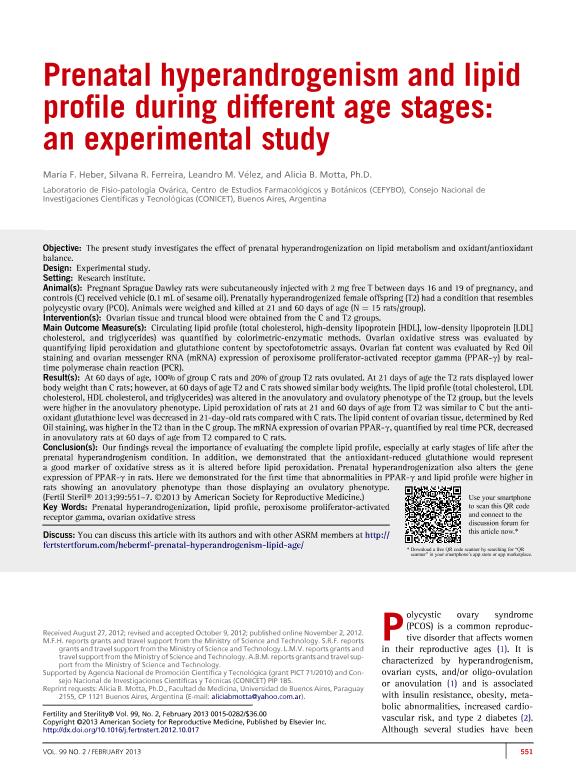Artículo
Prenatal hyperandrogenism and lipid profile during different age stages: an experimental study
Fecha de publicación:
02/2013
Editorial:
Elsevier
Revista:
Fertility And Sterility
ISSN:
0015-0282
Idioma:
Inglés
Tipo de recurso:
Artículo publicado
Clasificación temática:
Resumen
Objective
The present study investigates the effect of prenatal hyperandrogenization on lipid metabolism and oxidant/antioxidant balance.
Design
Experimental study.
Setting
Research institute.
Animal(s)
Pregnant Sprague Dawley rats were subcutaneously injected with 2 mg free T between days 16 and 19 of pregnancy, and controls (C) received vehicle (0.1 mL of sesame oil). Prenatally hyperandrogenized female offspring (T2) had a condition that resembles polycystic ovary (PCO). Animals were weighed and killed at 21 and 60 days of age (N = 15 rats/group).
Intervention(s)
Ovarian tissue and truncal blood were obtained from the C and T2 groups.
Main Outcome Measure(s)
Circulating lipid profile (total cholesterol, high-density lipoprotein [HDL], low-density lipoprotein [LDL] cholesterol, and triglycerides) was quantified by colorimetric-enzymatic methods. Ovarian oxidative stress was evaluated by quantifying lipid peroxidation and glutathione content by spectofotometric assays. Ovarian fat content was evaluated by Red Oil staining and ovarian messenger RNA (mRNA) expression of peroxisome proliferator-activated receptor gamma (PPAR-γ) by real-time polymerase chain reaction (PCR).
Result(s)
At 60 days of age, 100% of group C rats and 20% of group T2 rats ovulated. At 21 days of age the T2 rats displayed lower body weight than C rats; however, at 60 days of age T2 and C rats showed similar body weights. The lipid profile (total cholesterol, LDL cholesterol, HDL cholesterol, and triglycerides) was altered in the anovulatory and ovulatory phenotype of the T2 group, but the levels were higher in the anovulatory phenotype. Lipid peroxidation of rats at 21 and 60 days of age from T2 was similar to C but the antioxidant glutathione level was decreased in 21-day-old rats compared with C rats. The lipid content of ovarian tissue, determined by Red Oil staining, was higher in the T2 than in the C group. The mRNA expression of ovarian PPAR-γ, quantified by real time PCR, decreased in anovulatory rats at 60 days of age from T2 compared to C rats.
Conclusion(s)
Our findings reveal the importance of evaluating the complete lipid profile, especially at early stages of life after the prenatal hyperandrogenism condition. In addition, we demonstrated that the antioxidant-reduced glutathione would represent a good marker of oxidative stress as it is altered before lipid peroxidation. Prenatal hyperandrogenization also alters the gene expression of PPAR-γ in rats. Here we demonstrated for the first time that abnormalities in PPAR-γ and lipid profile were higher in rats showing an anovulatory phenotype than those displaying an ovulatory phenotype
Archivos asociados
Licencia
Identificadores
Colecciones
Articulos(CEFYBO)
Articulos de CENTRO DE ESTUDIOS FARMACOLOGICOS Y BOTANICOS
Articulos de CENTRO DE ESTUDIOS FARMACOLOGICOS Y BOTANICOS
Citación
Heber, María Florencia; Ferreira, Silvana Rocío; Velez, Leandro Martin; Motta, Alicia Beatriz; Prenatal hyperandrogenism and lipid profile during different age stages: an experimental study; Elsevier; Fertility And Sterility; 99; 2; 2-2013; 551-557
Compartir
Altmétricas




